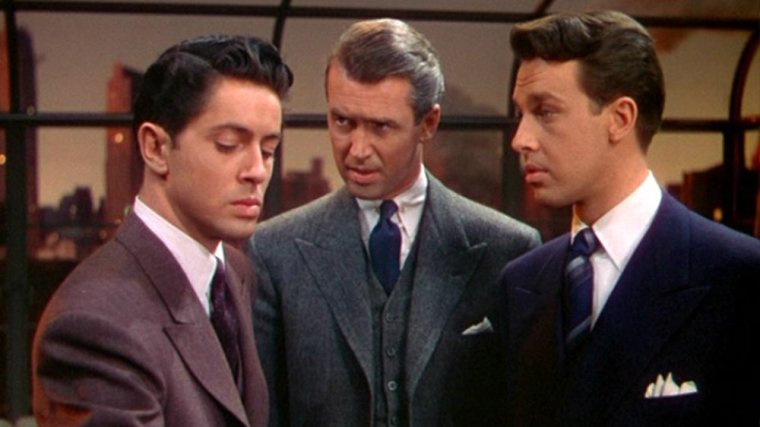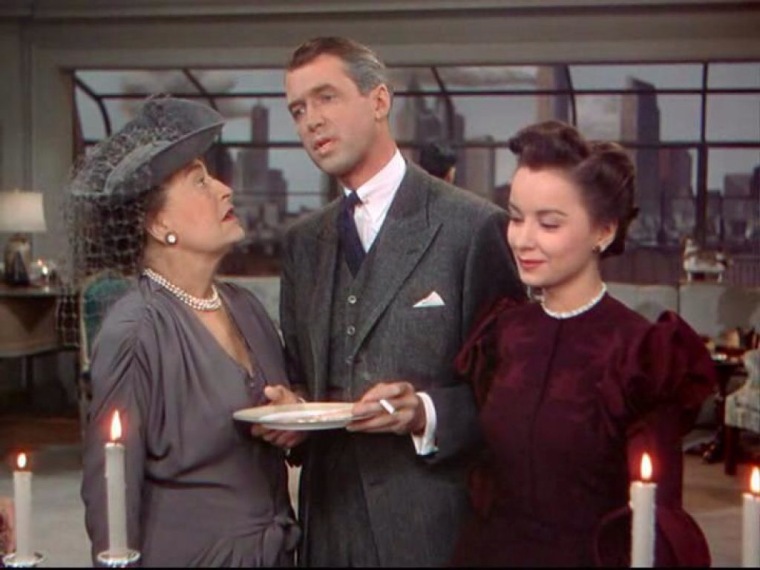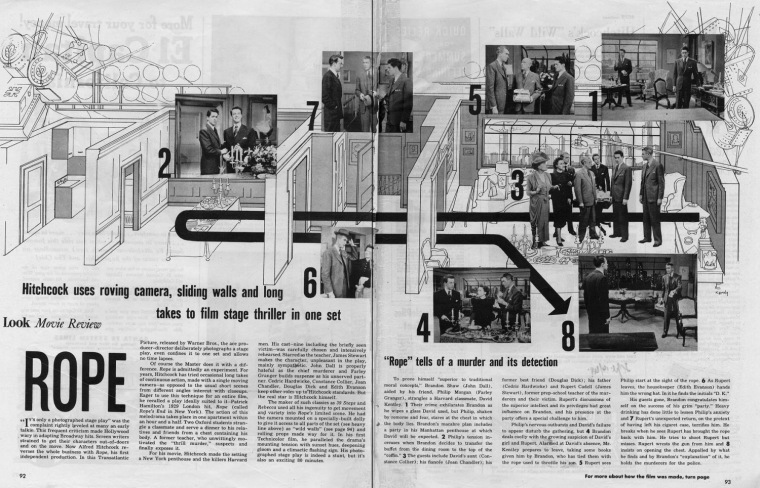
John Dall (R) stays calm while Farley Granger (L) becomes unravelled. Image: Talk Film Society
There are two things that fascinate us about the lesser-known Alfred Hitchcock film, Rope (1948).
The film, based on a stage play by Patrick Hamilton, was inspired by the infamous Leopold and Loeb murder case. (In 1923, two wealthy young men from Chicago kidnapped and murdered a 14-year-old boy “solely for the thrill of the experience.”¹)
So. Our first fascination with Rope is John Dall‘s performance as a smarmy sociopath who thinks he’s superior to everyone around him, except his companion (Farley Granger) and his former teacher (James Stewart).
Dall and Granger play rich and spoiled New York socialites hosting a dinner party in honour of their friend named David. However, they murder the unfortunate David just before the other guests arrive.
The pair are not motivated by hatred or jealousy. Nay, their goal is more scientific – lofty, even. They want to prove the Intellectually Superior have the right to kill those they regard as inferior.
They dump the deceased into a large chest and cover it with a tablecloth upon which they serve dinner, but that’s not the worst of it. The party guests include David’s relatives and fiancé, all of whom grow increasingly anxious about his absence.
Meanwhile, Dall is exhilarated by the act of murder, and he’s dying to gloat about it so everyone can marvel at how smart he is. When Stewart voices his suspicions, Dall’s excitement intensifies. Someone’s on to him! Whee! It’s the best night of his life!
Superior intellect, indeed.

Constance Collier (L) and Joan Chandler are amused by Stewart’s theories. Image: IMDb
The second fascinating aspect, to us, is one that’s been heavily criticized; namely, the techniques Hitchcock used in this film.
Hitchcock treated Rope as though it were a live stage play, creating the illusion of one long, continuous action, broken up by 10-minute takes. “The only genuine cuts were dictated by a length of a film reel, with the breaks between reels usually disguised by an actor passing in front of the camera just as the footage ended,”² writes Patrick McGilligan in Alfred Hitchcock: A Life in Darkness and Light.
The film was shot on a set with a felt-covered floor and collapsible walls mounted on rubber wheels, which moved to the side when the camera followed the actors from room to room.
The set also included an expansive living room window, showcasing the New York skyline, “complete with miniaturized buildings and clouds of spun glass hung on wires, to be moved between reels to simulate a shifting sky.”³
To choreograph the movement of the set and the actors, the action was blocked out beforehand on a blackboard. “Even the floor was marked and plotted with numbered circles for the 25 to 30 camera moves in each ten-minute reel,” said Hitchcock.4
Here’s a diagram of the set:
Although seasoned theatre actors Cedric Hardwick and Constance Collier were non-plussed by the mechanics of this unorthodox production, the rest of the cast found it very challenging.
“It was hard to see how the picture was going to work even while we were doing it,” said Stewart. “The noises made by the moving of the walls was a continual problem, and we would have to do scenes over again just for sound reasons, using only microphones like in a radio play.”5
Then there was the prop staff, who constantly moved and rearranged furniture off camera. “One of my biggest problems,” said Farley Granger, “was having to trust that when I sat down, there would be a chair under my rear end, that the stage hand had gotten it there in time.”6
Some film critics feel Rope is gimmicky, but French film director François Truffaut praised the effort, saying it should not be seen as a foolish endeavour. “A director is tempted by the dream of linking all of a film’s components into a single, continuous action,” he told Hitchcock. “In this sense, it’s a positive step…”7
If you haven’t yet seen Rope, you ought to take a look. Even if you don’t feel the result is entirely successful, you’ll marvel at the logistics – and the stellar performances.
Notes
- ¹Baatz, Simon. (2008, August) Leopold and Loeb’s Criminal Minds.
- ²McGilligan, Patrick. (2003) Alfred Hitchcock: A Life in Darkness and Light. New York, NY: Regan Books, p. 411.
- ³Ibid.
- 4“Production Notes” Rope, The Alfred Hitchcock Collection, DVD (Universal City, CA: 2000).
- 5Ibid.
- 6Ibid.
- 7Ibid.
- This post is part of the SECOND ANNUAL ALFRED HITCHCOCK BLOGATHON hosted by Maddy Loves Her Classic Films.
Rope: starring James Stewart, John Dall, Farley Granger. Directed by Alfred Hitchcock. Written by Arthur Laurents. Warner Bros. Pictures, 1948, Technicolor, 81 mins.














This is one of my fave Hitch movies. Yes, there’s some artful deception in the film-making, but it really works quite well…
LikeLiked by 1 person
Agreed. I think this film works well and I can’t understand why it’s not better known. And the acting! Fab!
LikeLiked by 1 person
Brilliant film and I think a film experiment that was successful. I love the window in this film and how the light changes, and slowly the outside of the window turns to night.
When I first saw this I was in my teens, and I didn’t notice the shots which were actually the hidden cuts. When I watched it again much later I did notice them; shots such as the camera suddenly zooming in on a back for example.
So much suspense and disgust as we know what is in the chest, and we also know how twisted Brandon is. It really keeps you on the edge of your seat throughout.
Great write up, Ruth. Thanks for joining.
LikeLiked by 1 person
Thanks, Maddy. I think the film has a lot of suspense, especially the scene where Mrs Wilson starts to clear the books off the chest. I love the way Hitchcock filmed that scene.
LikeLike
Great review, and that diagram of the set is so fascinating! I really think this was a successful enough “experiment”. It is a pleasure watching everyone act, ponder the details and the audacity of the main characters.
LikeLiked by 1 person
Audacity is right! Dall’s character is almost too much, but I think he needs to be, because we would hate ourselves for sympathizing with him. The performances are first rate, aren’t they, despite all the frustrating mechanics behind the scenes, e.g. the noisy walls.
LikeLiked by 1 person
The performances are amazing, and this is really the “theatre” movie that really works. But, then again, I strongly believe that only Alfred Hitchcock could have pulled it off so successfully, with all his insights into the cinema and what makes it all so effective.
LikeLiked by 1 person
I just recently listened to a podcast about Leopold and Loeb. What a pair of sickos! I hadn’t heard of this movie, but now I’m dying (ha ha) to find it to watch.
LikeLiked by 1 person
Haha! “Rope” is a lesser-known film, but I think it’s one of Hitchcock’s best. It’s cleverly done, I think.
LikeLike
I am fascinated and impressed by the fact that Hitchcock set challenges for himself at a point in his career where he could have coasted. I am mesmerized by his accomplishment in Rope and enjoyed your review immensely. There are still things for me to learn about the movie.
LikeLiked by 1 person
You said it! Hitchcock could have easily rested on his laurels in the late 1940s but, like you said, he was still setting challenges for himself as a filmmaker. That alone is to be applauded.
LikeLiked by 1 person
Invaluable, fascinating information – thank you.
LikeLiked by 1 person
Thanks! Can you believe I picked up a well-wriiten, never-been-read Hitchcock bio at a used book sale for $2? Could hardly believe my luck! Anyway, this book is crammed with great filmmaking secrets.
LikeLiked by 1 person
Which one? Spoto’s was my textbook for a class once. Loved it!
LikeLike
Great article Ruth! Yes, Rope was very interesting on the technical aspects and dark humor at its best! Definitely worth a look!
LikeLiked by 1 person
Dark humour is right! It’s a pretty edgy film.
LikeLiked by 1 person
This is certainly a movie that one has to go in knowing how it was filmed and what Hitchcock was trying to achieve. Otherwise it just feels strange. Once you have some background information it makes the film so much more enjoyable.
I understand the criticism of Hitch being gimmicky here, but then he always was. I think it worked to his advantage.
LikeLiked by 1 person
Very good advice. The first time I saw this film, many years ago, I didn’t understand why it was done the way it was, but I loved the feel of the continual action. When I learned more about the “why”, it immediately became a fave.
And I agree – the gimmickry definitely works here.
LikeLike
I haven’t seen this Hitchcock film before, but your review has intrigued me. I’ll have to check it out.
LikeLiked by 1 person
I hope you get the chance to see it. It’s an unusual film, but it is riveting.
LikeLike
rope is such a vastly interesting Hitchcock movie. rope was a wonderfully interesting idea that he tried to flim. The performances are amazing that you reviewed so much. It is an very wonderful gem
LikeLiked by 1 person
I agree that it’s a wonderfully interesting idea, as you said. It had to be tried at some point, and Hitchcock was the best one to do it.
LikeLiked by 1 person
Just watched it for the first time. Was curious how much it captured of the Leopold and Loeb crime. The film is riveting, as you say, and so disturbing, and wow, Stewart! He’s amazing in it. I need to watch it again to catch all those takes….
LikeLiked by 1 person
James Stewart truly is amazing in this film, isn’t he? He’s amusing and charming, but also shows a barely-controlled fear and anger. Everyone here gives a terrific performance.
LikeLike
Sounds intriguing! Thanks for posting this review–I want to see the film now!
LikeLiked by 1 person
I hope you get the chance to see it. It is unusual, but worth it.
LikeLiked by 1 person
Rope is second only to Psycho in my list of favorite Hitchcock movies. Even more so when I learned how he did it. Good review.
LikeLiked by 1 person
Thanks! You really have to admire the planning and organizing that went into this film, never mind the script and performances. There aren’t many people who could pull it off, no?
LikeLike
I think the idea was slightly crazy, especially given the enormous technical limitations of the time, and a nightmare for the actors. But you have to admire his audacity, willingness to experiment and the technical skill and effort involved. Surprisingly, Hitch persevered with ten minute takes on the historical film Under Capricorn, but it was a bit of a disaster and he gave up on the idea.
LikeLiked by 1 person
Yes, this was a bold, difficult plan, but I like the end result.
I’ve never seen “Under Capricorn” despite the cast, and I didn’t realize Hitchcock wanted to continue with ten-minute takes. I’ll have to track it down, now that you’ve mentioned it.
LikeLike
It was an experiment gone well, very well! 🙂
LikeLiked by 1 person
Haha! I’m glad you agree. I think so, too. It makes for a fascinating movie, doesn’t it?
LikeLiked by 1 person
Indeed!
LikeLike
Love this film!
LikeLiked by 1 person
Me too! I find I can’t NOT watch it when it’s on. I don’t think Hitchcock could have assembled a better cast, even if Jimmy Stewart was a second choice after Cary Grant.
LikeLiked by 1 person
Yeah! I don’t even think he was miscast, as a lot of people do. Sure, it’s not the most show-y of Jimmy’s roles, but it’s a great performance nonetheless.
LikeLiked by 1 person
I’ve never seen Rope but you have me very interested in seeing it! It’s definitely on the viewing list. I was also interested in the background and context of the film, particularly that it was indirectly drawn from the Leopold and Loeb case. Thanks so much for sparking an interest in the film for me.
LikeLiked by 1 person
What?! You’ve never seen this film? I am shocked – SHOCKED. Well, you have some good viewing ahead, and I’m looking forward to your review. (Hint hint)
LikeLiked by 1 person
Ha, ha! I have some homework to do! Will get right on it!
LikeLiked by 1 person
I remember when I first saw this in my Hitchcock film class in college many moons ago and being fascinated by those minimal takes for one film. It was amazing. I did wonder about the process and the set (can’t recall if it was discussed then) but I know these interviews would have really emphasized it. Wow… they did so well, their frustration with the production isn’t noticed. Dall was such an a-hole in this, wasn’t he?! LOL. Thanks for reminding to watch this again soon. It’s been a while.
LikeLiked by 1 person
Haha! Yes, Dall’s character was a real piece of work, that’s for sure.
It would have been interesting to watch this being filmed, no? Just to see how they moved the camera and the walls, and to see props people madly re-organizing the furniture. An incredible production.
LikeLike
Yes!!!! I had no idea about the set. Cant wait to watch again soon just to try to catch those details. Of course, I won’t – its Hitch 😄, but it’s worth a try!! 🙂
LikeLiked by 1 person
I took a whole class on Hitchcock in college and we watched Rope. It is definitely unique even for Hitchcock! Also funny to read your post on it, since an old film buff friend of mine and I were just discussing it last night! Well done as always 🙂
LikeLiked by 1 person
When you studied Hitchcock in College, did the class cover many of his silent films? Just wondering.
LikeLiked by 1 person
Not too many of his silent films unfortunately. However it did cover some of his very early and lesser known works. It was a really fascinating class!
LikeLiked by 1 person
I really enjoyed your explanation of the set, the camera movement, how the movie was made!!! Hitchcock truly was a genius. Love this movie.
LikeLiked by 1 person
It was a daring experiment that worked well, in my opinion. I like the feel of “real time”.
LikeLiked by 1 person
I love suspenseful murder plots and yet never watched this Hitchcock movie. The story of Leopold And Loeb is creepy indeed. Especially due to the fact that the little boy was Loeb’s cousin. Creepy. Great review!
LikeLiked by 1 person
Eww – I didn’t know the boy was Loeb’s cousin. That makes it all the more creepy, like you said.
LikeLiked by 1 person
I know, right? out of this world!
LikeLiked by 1 person
Thanks so much for a fascinating blog on a fascinating film! I love hearing about the mechanics and genius of film making and this did not disappoint. I knew about the long takes but not the info about the movement of walls and furniture on set. This one mesmerizes from the first foot of film to the last.
LikeLiked by 1 person
I agree that this is an utterly mesmerizing film. Very clever with the moving walls & furniture, no? It would’ve been something to be a visitor during filming, I think.
LikeLiked by 1 person
This is one of many sets I’d love to visit!
LikeLiked by 1 person
Remarkable film. Great article. RE-posted on twitter @trefology
LikeLiked by 1 person
That’s great! Thanks for sharing. 🙂
LikeLiked by 1 person
HAPPY BIRTHDAY ALFRED HITCHCOCK!
LikeLiked by 1 person
You posted some great images on your site to celebrate his birthday. Here’s to Hitch! *clink!*
LikeLiked by 1 person
It’s actually one of my Hitchcock’s favorites. Like you said, everything is on track: acting, suspense, technological innovation. Great effort but great result, both funny and intriguing. Nowadays, with digital technology, every filmmaker can do a sequence shot without effort, but we rarely see results as memorable as Hitchcocks’. This movie will never be remembered enough, thanks!
LikeLiked by 1 person
It’s one of my favourites, too, and it should be more widely remembered these days, as you pointed out. I recently saw 1917, where they used the “one continuous shot” to great effect, but it isn’t a memorable film, like Rope is.
LikeLiked by 1 person